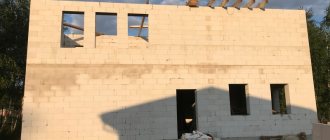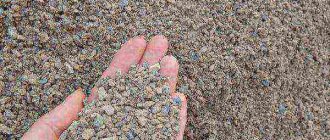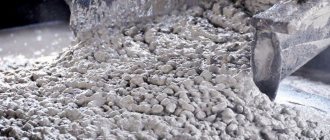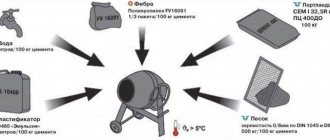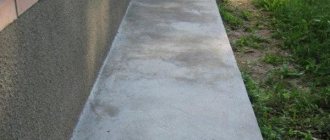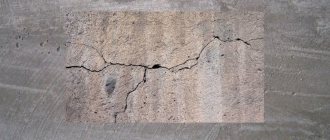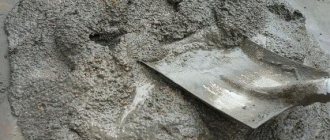The foundation is the basic, most important part of the future structure. You should carefully consider all the features of the foundation and decide on the key points of its construction. Concrete consumption is quite high; the cost of installing a high-quality foundation is approximately a third of the cost of all work.
The materials cannot be called cheap either. For example, inexperienced people in construction often make a common mistake. They do not pre-calculate the concrete and order much more concrete mixture than is actually needed for pouring into the formwork.
The use for excess concrete is most often not found on construction sites. So you have to either return the already paid (and expensive) building material, or completely send it to scrap. And all because of basic inexperience or unwillingness to waste time on calculations. In the same case, if you order too little concrete, then your problems may be even more serious. So how to calculate concrete consumption correctly, according to all the rules? Let's try to answer this question.
Concrete consumption and concrete loss after pouring
Concrete is considered one of the most popular materials used in construction at the moment.
This is due to its unique combination of availability, performance and cost. In any case, the consumption of concrete is very high when creating most objects. It is here that such an important quality of the mixture as its affordable cost plays a decisive role. The material has become widespread when it is necessary to construct the foundation for a building, as well as the foundation. The monolithic tape type of construction has gained popularity due to its ease of manufacture. The vast majority of structures in private construction are built on such a foundation. It can be created even by a person who does not have special knowledge in this field. It is enough to follow the established rules and ensure the consumption of concrete at the level of the specified parameters. This will allow you to achieve a very effective and durable result. It is very important to calculate concrete consumption before construction begins. The reason is the need to predict costs and ensure they are kept to a minimum. If the concrete consumption is calculated incorrectly, certain problems will arise during the construction process. When an insufficient number of constituent components has been purchased, the mixture will not be enough to provide the required volumes. This is a very serious problem and it cannot be solved in a short time. When issues such as concrete consumption and concrete loss after pouring are considered, the need to ensure that the quantity is appropriate is taken into account. The optimal option for laying the mixture is considered to be the requirement to ensure this process at a time. Only in this case can we achieve minimal defects and ensure the creation of a monolithic structure. Concrete consumption in any case does not differ from each other and this should be taken into account. If the structure is already filled, but additional measures are required, then a cold seam is created. Its presence is undesirable, but, as practice shows, in some cases it is difficult to do without it. The cold weld technology is quite simple and can be carried out even by a person who does not have sufficient experience in this field. As already mentioned, the consumption of concrete when creating a monolithic structure poured at one time and a variant containing a seam does not change.
If we consider a situation where too many components are taken, then not all reserves will be used. This will entail some monetary losses, since the consumption of concrete will not be able to cover the entire amount of the available composition. It should be noted that this option is standard if only part of the mixture is used. At the same time, concrete consumption should be calculated in such a way as to ensure a minimum amount of residue. If such a situation could not be achieved, you should pay attention to numerous construction markets. They can be used to sell surpluses, which will somewhat minimize economic losses.
Concrete consumption is calculated based on simple formulas and parameters. This allows calculations to be carried out even by those who do not have the relevant experience and skills in carrying out construction activities. To calculate the consumption of concrete, you need to decide on its brand. Different proportions imply different volumetric mass. All necessary information can be found in specialized documents, as well as state standards. But, in this case, a thorough check of the components used is implied. They must also meet established requirements and have documents. In this case, concrete consumption is calculated as accurately as possible. The next point is to determine the volume of the structure. Additionally, such factors as concrete loss after pouring are taken into account. They will be discussed below. Calculating the volume of a structure (foundation, base or other option) may seem like a difficult task, but this is only the first impression. This event is distinguished by its simplicity if it is divided into standard blocks of the correct shape. In this case, the consumption of concrete is determined by multiplying the sides of the elements and then adding them. It should be noted that, just in case, a slightly larger number of components are purchased. This allows you to slightly increase the consumption of concrete, but provides the opportunity to insure against various unforeseen situations. It should be noted that this parameter strongly depends on the brand of the mixture being created.
If we consider the composition of the composition, we cannot fail to mention some extremely important points that have a serious impact. First of all, this includes the loss of concrete after pouring. It is necessary to consider the features of the process, its causes and factors of occurrence. Losses of concrete after pouring are due to its chemical composition and reactions between components. To be more precise, the main role is played by the interaction between the binder material and water. This reaction determines the loss of concrete after pouring, but it is this reaction that makes it possible to achieve high performance characteristics of the application, as well as the hardening of the mixture into a monolithic mass. The interaction between the binder material and water occurs over a long period of time. At the same time, the peak of leakage begins a few hours after installation and continues for several days. Ultimately, it is possible to achieve the formation of a solid composition. Now we should take a closer look at why concrete is lost after pouring. They are caused by a decrease in the volume of the mixture during the process of hardening. For example, water evaporates very actively from the surface, which requires constant hydration. Additionally, the volumetric mass of the water and binder material that has passed through the reaction process increases slightly. This figure is relatively small, but it is enough to ensure the loss of concrete after pouring. If this point is not taken into account, then some problems will arise quite quickly. For example, the standard reduction in the foundation level is several centimeters after the mixture hardens. This is a minor parameter and does not cause serious problems in this area of construction. The loss of concrete after pouring is much more serious if we consider the creation of monolithic slabs or any other blocks. In this case, it is recommended to carry out special preparation. It should be noted that since the blocks are often made in factories, the loss of concrete after pouring is not so dangerous in such a situation. Strictly calculated parameters and mixtures with specified characteristics are used. The machine measures the volume of material in such a way that the loss of concrete after pouring does not affect the finished dimensions of the manufactured reinforced concrete products. It should be noted that, as opposed to reducing the volume, the reinforcement increases this parameter. Often, the loss of concrete after pouring and the use of the frame do not compensate for each other and this requires complex calculations from the machine. High-precision equipment allows you to solve this problem with maximum efficiency.
Factors such as loss of concrete after pouring can cause the greatest problems when mixing the composition yourself. Often, most private developers adhere to this option, since the cost of delivering the mixture using a concrete mixer truck is very high. Additionally, for this area of construction there is no need for a high quality product. The losses of concrete after pouring when mixed independently are very large, since the proportions are not always respected. Additionally, adding too much water to the mixture is a very common situation. Since there is excess, it cannot enter into a chemical reaction with the binder and determines the loss of concrete after pouring. Water has the minimum density among all components of the composition. This leads to its rise to the top, where evaporation occurs. Thus, the volume is reduced much more than in normal cases. It is worth saying that the greater the loss of concrete after pouring, the more significantly the strength decreases. In general, if the surface of a created and hardened structure is not properly cared for, its strength indicators will decrease by 10-40 percent. This will have a very negative impact on further operation, as it reduces its durability.
When concrete loss after pouring is large, procedures may be required to make up for this type of problem. To do this, additional formwork is created on the upper part or poured into the existing structure if it has not yet been dismantled. Since the work is carried out using cold weld technology, special attention should be paid to it. If a gap or any other voids appear between the already hardened layer and the new one, this will lead to the possibility of water entering them, which will have an extremely negative impact on the strength of the structure in the future.
By controlling the loss of concrete after pouring, very effective results can be achieved and this should be taken into account in order to achieve a high quality structure.
Cement consumption per 1 m2 of screed: how to correctly calculate the material
Calculating the consumption of cement screed per 1 m2 is a mandatory procedure, which allows you to determine the exact ratio of components, in particular cement. It is the correctness of the obtained indicators that makes it possible to create a basis that is reliable and durable. Expense also determines the financial costs that will be required to purchase materials.
Calculation nuances
It must be taken into account that the calculation of the screed is made taking into account its constituent components. The main substances are cement and sand, to which the necessary additives are mixed. The mixture is made by adding water. The final result depends on the resulting ratio.
The material consumption can also be affected by the purpose of the coating:
- Creating a surface that will be used in a technical room. This could be the floor in a utility room or garage.
- Pouring a rough coating with a thickness of 80 mm or more. For this purpose, a concrete mixture for floor screed, which includes a coarse fraction, is best suited. To obtain lower values, a cement-sand mortar also copes with the task, but subject to reinforcement.
- The finishing option, which serves as the basis for subsequent cladding with decorative materials. The coating has a thickness from 5 to 30 mm.
The main thing is to correctly determine the purpose of the surface in order to create a truly reliable structure.
Preparation process for determining flow rate
Before performing the necessary calculations, you should carry out preparations that will help you achieve an accurate result:
- Everything unnecessary is removed from the room; the base must be completely free. If necessary, the old coating is removed.
- The surface is assessed for possible damage. If there are cracks, they are filled with putty.
- After initial preparation, the zero level is set. According to the measurements of height differences, the final thickness of the coating is determined. This indicator is one of the main ones for calculating the cement consumption for screed when pouring 1 m2.
Determining the screed level
Note! It must be taken into account that the values of 1 m² when working with floor screed are not entirely correct, since the surface has a third indicator - thickness. This is why cubic values are initially determined.
Screed calculation technology
Calculation of screed consumption begins with choosing the optimal composition for the job. Currently, there are two large groups: ready-made mixtures and solutions that require preparation. The first variety is much preferable, since it already has the exact amount of necessary components and additives.
Calculation of the finished dry mixture
Due to the fact that ready-made dry mix for screed allows you to get a better result, it is becoming more and more popular. It must be taken into account that the characteristics of the finished formulations vary, so you should familiarize yourself with the products in advance.
Characteristics that are written on the packaging of the finished mixture for screed
Each package contains information about material consumption per 1 m2 with a coating thickness of 1 or 10 mm. To obtain values depending on the actual thickness, the following actions are performed:
- The total area of the room is calculated by multiplying the length and width. In case of a complex configuration, it is advisable to refer to the plan of the house or apartment.
- The thickness of the floor is converted into meters, the indicators are multiplied.
- The resulting value is divided by 0.1.
Calculation example:
Room area 10 m2. The required thickness is 0.05 m.
10*0,05 = 0,5/0,1 = 5.
The approximate consumption of the finished composition for a 10 mm floor screed is 14.6 kg.
14.6*5 = 73 kg of dry matter.
Thus, the total amount of the required composition per 10 m2 with a thickness of 50 mm is 0.5 cubic meters. Water is added based on conditions that are determined individually by each manufacturer.
Consumption of traditional solution
Material consumption for a floor screed prepared by yourself
To calculate the required amount of composition prepared by yourself, you need to do the following:
- The cubic value is determined by multiplying the area by the thickness. For example, 30 m2*0.04 m = 1.2 m3.
- Cement consumption per 1 m2 of screed is calculated at the rate of one part cement to three parts sand.
- The total number of parts is 4, which means 0.3 m3.
0.3 is a portion of Portland cement per area of 30 m2 with a thickness of 40 mm. Sand accounts for 0.9 m3.
- Based on approximate data, one cubic meter of cement is equal to 1300–1400 kg.
1300*0.3 = 390 kg.
- One cubic meter of sand is 1625 kg.
1625*0.9 = 1462 kg.
- To obtain a solution, water is added to the dry components, its amount varies from 0.3 to 0.5 liters per 1 kg of cement.
Thus, for 30 m2 with a coverage of 40 mm, 1852 kg of dry mixture and about 200 liters of water will be required. Accordingly, 61 kg of composition and 6.5 liters of liquid are needed per 1 m2.
© When copying material, a link to the site https://otdelkagid.ru is required!
otdelkagid.ru
Factors that cause concrete shrinkage
During the hardening of the concrete mass, physical and chemical processes occur in it that change the structure. Shrinkage is a consequence of these changes. It continues during and after the concrete hardens, which must be taken into account when creating structures.
Types of processes leading to concrete shrinkage during drying:
- removal of moisture;
- carbonization;
- contraction shrinkage.
It has been established that cement has a granular base and water penetrates deeper gradually, forming hydrosilicates. Hydration requires a long period of weeks. At this time, water evaporates from the surface layer, and shrinkage cracks appear, reducing the strength of concrete. Evaporation of moisture from the inner layers occurs if the capillaries between the grains are less than 0.1 microns.
Contraction shrinkage is the tightening of a mass as a result of hydration. Occurs in fresh concrete due to the formation of calcium hydrogel.
Carbonation is the chemical reaction Ca(OH)2 + CO2 = CaCO3 + H2O. The result is limestone, and water is displaced through capillaries. The material is compacted, which leads to air shrinkage of the concrete.
The reduction in linear dimensions continues for up to one and a half years, which should be taken into account during construction. To stabilize the process and reduce the shrinkage time of concrete, the mass is reinforced, increasing the strength qualities of the monolith. At the same time, a mixture with additives is used, pouring the mass under pressure with vibration to reduce shrinkage to negligible.
Concrete shrinkage coefficient
The indicator determines by what percentage the initial volume or linearity of the structure is reduced during the period allotted for strength gain. The permissible shrinkage of concrete according to GOST 24544-81 is up to 3%, the average is about 1.5%.
The indicator is determined by summing up the periods of mass hardening and strength gain.
- Plastic shrinkage of concrete when pouring, 4 mm/m
- Autogenous shrinkage - the first week, “young” concrete shrinks by 1 mm/m.
- Concrete shrinks during the year up to 5mm/m.
Linear dimensions when summed and converted into volumetric ones are established for different grades of concrete. Based on the tests, the concrete shrinkage coefficient is regulated in GOST.
Calculation of the mixture needs taking into account concrete shrinkage is carried out using the formula V=H*S*K, where:
- V – product volume,
- S – surface area,
- Kus is the shrinkage coefficient of concrete.
The accepted coefficient is 1.1. This means that the consumption of concrete solution is 10% more than the volume of the finished product, taking into account losses and shrinkage.
Principles of flow calculations
The concrete consumption rate is calculated in cubic meters. This value cannot be measured in tons or kilograms, because the solution can have different weights depending on the composition of additional impurities and the brand of cement that was used to mix the mixture. For example, one cube of reinforced concrete weighs 2500 kg, and the same size of expanded clay concrete on sand weighs about 1000 kg.
Before calculating the consumption of a cube of concrete for complex structures, they are conventionally divided into simple geometric shapes.
Concrete consumption is affected not only by the brand, but also by the configuration of the construction site. If, when building a room with a strip foundation with dimensions of 10 by 10 m, 18 m3 of mortar is required, then for the same object with a slab foundation, only 10 m3 is needed
Ways to reduce shrinkage
You can prevent rapid drying of the top layer of concrete by periodically wetting the surface. At a temperature of 20-30 degrees and air humidity of 90%, the surface hardens without cracking. This requires moistening the surface or heating the plate in a steam environment.
Concrete shrinkage rates are reduced if used in a batch:
- expanding cements;
- additives to concrete that compensate for shrinkage;
- reduce cement content;
- reduce sand content.
The knead should be plastic, but contain a minimum amount of water. For this purpose, special additives and expanding Portland cements of the OBTC and BTC brands are used.
Shrinkage of concrete during hardening can be reduced by introducing plasticizers, adding lime, aluminum salts, and reinforcement, but it cannot be completely eliminated. The introduction of porous fillers reduces the indicator by 2.5 times. Forming using vibration compaction reduces the amount of concrete shrinkage by 0.6-0.8%.
How to calculate the shrinkage of concrete in a batch
Laboratory tests make it possible to determine the fluidity of the mass and its shrinkage. The main methods are to deposit concrete in a cone and test a standard cube after hardening. The fluidity of concrete is the ability of the composition to spread when compacted with a vibrator, filling voids.
The indicator is standard, denoted by the letter “P” and the letter 1,...5. The higher the flow coefficient, the more water in the batch. For monolithic filling, mixtures P1, P2, P3 are used. They are prepared locally, the concrete is hard and sets quickly. Only P4 and P5 are delivered in a concrete truck.
The determination of “P” is carried out with a container in the form of a truncated cone with a volume of 6 liters and a height of 30 cm. It is determined how many cm the concrete has dropped after the cone has been removed from it.
Cone shrinkage flow table
| Indicator "Mobility" | Sample shrinkage, mm |
| P1 - sedentary | 10-50 |
| P2 - sedentary | 50-100 |
| P3 – general purpose concrete | 100-150 |
| P4 - highly mobile | 150-200 |
| P5 - highly mobile | >200 |
The study of a cube-monolith serves for more in-depth studies with accurate measurements of shrinkage. But the larger the number P, the greater the shrinkage, this is a regularity. By the shrinkage of concrete in the cone, you can judge how much the mass will settle when pouring the foundation, and calculate the required volume of solution.
Dry mixture consumption calculator for floor screed
Home > Concrete floors > Dry mix consumption calculator for floor screed
Dry mix for screed is a set of components mixed in certain proportions. Our online calculator will help you correctly calculate the consumption of the finished mixture; you just need to know the area of the room and the thickness of the layer.
Our calculator shows both the total amount of mixture required for your room and the amount of mixture per 1 m2 of screed at the specified thickness.
The calculator data may differ slightly from the actual consumption, both up and down, such an error is no more than 10-15%. There may be two reasons for this:
- differences in the level of the subfloor, differences in the height of the screed in different places,
- The thickness of the actual screed may differ from the planned one.
You can calculate the approximate consumption of the mixture for dry screed yourself. To do this, you need to know the area of the room and the thickness of the layer. The average consumption of the popular and most commonly used mixtures per 1 m2 is 15 kilograms per 1 centimeter of layer thickness.
One of the most popular dry screed systems is Knauf; online calculator for the consumption of this mixture is here.
- Order
calculation?
- Send
application?
- Order
call?
pol-zalivka.ru
Shrinkage joints in monolith
When pouring a monolithic slab or tape, it is necessary to make shrinkage joints. Small gaps cut into the body of the slab allow creating conditions for uniform shrinkage, without breaking the monolith. Break lines are drawn according to rules confirmed by calculation of concrete shrinkage.
The screed map is made up of squares or rectangles with an aspect ratio of 1:1.5. The lines must be without bends. The cutting distance is selected based on permissible temperature changes.
Indoors, seams are created every 6 meters, in an open area no more than 3 * 3 m. For paths, a distance of 3.6 m is sufficient. The seam does not cut through the entire thickness of the monolith, it is 1/3 or 1/4 of the thickness of the screed.
If the monolith represents a strong foundation, then drilling with a drill with a diamond attachment is used, which does not destroy the walls and cuts through the concrete like a knife through butter.
We calculate the cement for floor screed yourself
- Main functions and types of screeds
- Calculation algorithm
One of the main types of construction and repair work is cement screeds, which can serve different purposes and are structurally very different from each other.
But for all of them, the main main parameter is the consumption of cement for the screed.
Scheme of a cement floor screed: 1 - Base, 2 - Sand layer, 3-4 - Layers, 5 - Concrete screed, 6 - Tile adhesive, 7 - Tiles, 8 - Separating edge layer.
Main functions and types of screeds
Let's start by looking at the main functions of the screed
- leveling the surface for flooring (parquet, linoleum, laminate);
- improving the heat and sound insulation properties of the floor: absorption of household, impact, air noise and insulation of floors;
- concealment of pipelines and utilities;
- distribution of heat energy in floors with built-in heating;
- giving coatings a given slope.
Below we list the main types:
Screed thickness diagram.
- by design: single-layer (one layer for the entire thickness) and multi-layer (includes heat-, hydro- and sound-proofing layers);
- by composition: cement-sand, concrete, self-leveling synthetic resins and mosaic (on top of a concrete screed), gypsum;
- according to the method of fastening to the ceiling: bonded screeds (directly bonded to the base), on a separating layer (additional waterproofing layer) and “floating” (laid on top of heat and sound insulating material).
In each of these types, the consumption varies depending on the selected brand of binding material, its quantity per unit of solution, and the technology for preparing the mixture. Failure to comply with certain regulatory rules and instructions in these matters can lead to delamination of the mixture, cracks on the surface, large pieces of screed falling out and the formation of voids.
Calculation algorithm
According to building rules, the consumption of cement for screed in kilograms is per cubic m (1m3) of solution. Sometimes it is more convenient to calculate the amount of binding material per cubic meter of sand. To calculate the total amount of the mixture, you need to know the total need for the solution (in cubic meters) for the working surface. Let's look at the calculation of cement for screed using examples.
Floor screed diagram.
- 1 m3 of solution. Single-layer cement-sand screed. Recommended brand of mortar M200 (cement/sand ratio 1:3);
- for 1 m3 of M200 mixture, according to the standard (see table), 410 kg of M500 cement is required;
- let the surface area be 12 m2, and the thickness of the screed be 30 mm. Calculation of the volume of the solution (multiply the surface area by the thickness): 12 * 0.03 = 0.36 m3;
- cement consumption: 410 * 0.36 = 147.6 kg, or 3 bags of 50 kg (regular packaging). This quantity is one part;
- calculation of sand and water. To obtain the finished mixture, add 3 parts of sand (3 * 147.6 = 442.8 kg - 9 50 kg bags) and 0.5 parts of water (147.6 * 0.2 = 73.8 l - 7.5 buckets) ;
Add water to the well-mixed dry mixture in small portions, constantly stirring the solution with a trowel, spatula or shovel. So, for a room with an area of 12 m2 and a screed 3 cm thick, we will need 3 bags of M500 cement, 9 bags of sand and 7.5 buckets of water. Cement standards for various brands of mortar can always be found either in the instructions supplied with the cement on the packaging or bags upon purchase, or on the Internet pages in the codes of practice of the joint venture “Preparation and use of mortars” (see table).
To calculate the cement consumption for screed, based on its norm per 1 m3 of sand, you can use the table below, in which the sand moisture content is in the range of 3-7%.
| Consumption for solution brand M200: | ||
| Cement brand | Cement consumption, kg | |
| per 1 m3 of solution | per 1 m3 of sand | |
| M500 | 410 | 360 |
| M400 | 490 | 450 |
| Consumption for brand M150: | ||
| M500 | 330 | 280 |
| M400 | 400 | 350 |
| M300 | 510 | 470 |
When using concrete, fillers are added to the known components cement, sand, water: crushed stone, gravel or lime paste in various proportions and the calculation is made according to the specified algorithm.
Note that to improve waterproofing, sand and cement for screeds are used together with bitumen paper, roofing felt or polyethylene film (no more than 300 microns thick). Increased strength is provided by cement for screeds, laid on a reinforcing mesh with cells of 100 * 100 and 150 * 150 mm, and good soundproofing properties are provided by materials: mineral wool, foam plastic, polystyrene, polyurethane, laid first on the base of the floor.
As you can see, calculating cement for screed with your own hands using a tape measure and a calculator is not at all difficult and, in terms of the amount of knowledge, is quite accessible to those who have completed secondary education.
1pokirpichy.ru
Concrete maturation standards
As soon as the cement comes into contact with water, the reaction begins to form a hydrogel - a binder. The period of plastic shrinkage lasts 8 hours, starting from mixing. Therefore, the rigid mixture is laid immediately, and highly mobile trains are made for delivery over a distance.
Within 7 days, hydration in the concrete mass is completed and limestone crystals form. 70% strength is gained. After 28 days, the concrete solution should turn into a monolith, meeting 100% strength requirements.
It is important to use all methods to accelerate the maturation and shrinkage of concrete in order to neglect the reduction in linear dimensions after 28 days in calculations. Brands of practically non-shrinkable concrete based on plasticizers are already in use; solutions are called non-shrinkable. They are used on critical construction sites.
